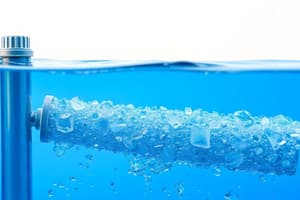Podcast
Questions and Answers
What is the operational characteristic of ultrafiltration?
What is the operational characteristic of ultrafiltration?
- Movement of water across a membrane due to a pressure gradient (correct)
- Movement of electrolytes across a membrane due to diffusion
- Movement of solutes across a membrane due to osmotic pressure
- Movement of blood cells across a membrane due to capillary permeability
What is the impact of hemoconcentrators on circulating concentrations of drugs and ions?
What is the impact of hemoconcentrators on circulating concentrations of drugs and ions?
- They can help manage blood volume, hemoglobin, protein, and certain electrolyte concentrations (correct)
- They cause a significant increase in drug concentrations in the blood
- They cause a decrease in blood volume and hemoglobin levels
- They have no impact on drug or ion concentrations
What is the purpose of ultrafiltration and dialysis in the context of CPB and related extracorporeal technologies?
What is the purpose of ultrafiltration and dialysis in the context of CPB and related extracorporeal technologies?
- To reduce the need for CPB and related extracorporeal technologies
- To attenuate fluid overload and electrolyte imbalances (correct)
- To increase the systemic inflammatory response syndrome (SIRS)
- To promote capillary permeability and shifting of fluid to the extravascular space
What is the definition of ultrafiltration?
What is the definition of ultrafiltration?
What did Thomas Graham's 1854 paper describe?
What did Thomas Graham's 1854 paper describe?
Who performed the first clinical dialysis procedure?
Who performed the first clinical dialysis procedure?
Who built an artificial kidney using a regenerated cellulose membrane after World War II?
Who built an artificial kidney using a regenerated cellulose membrane after World War II?
Which development reduced blood volume and increased membrane surface area?
Which development reduced blood volume and increased membrane surface area?
Who began the development of the hollow fiber dialyzer in 1956?
Who began the development of the hollow fiber dialyzer in 1956?
When did the hollow fiber dialyzer become commercially available?
When did the hollow fiber dialyzer become commercially available?
How is ultrafiltration achieved?
How is ultrafiltration achieved?
What does a semipermeable membrane allow to pass through its microscopic holes?
What does a semipermeable membrane allow to pass through its microscopic holes?
What does ultrafiltration remove from the blood using a microporous membrane material?
What does ultrafiltration remove from the blood using a microporous membrane material?
What is the process of ultrafiltration also known as?
What is the process of ultrafiltration also known as?
What is the formula to calculate the transmembrane pressure (TMP) in ultrafiltration?
What is the formula to calculate the transmembrane pressure (TMP) in ultrafiltration?
What does an increase in transmembrane pressure (TMP) do to the rate of effluent removal in ultrafiltration?
What does an increase in transmembrane pressure (TMP) do to the rate of effluent removal in ultrafiltration?
What is the sieving coefficient in ultrafiltration used to measure?
What is the sieving coefficient in ultrafiltration used to measure?
What is typically not removed by ultrafiltration?
What is typically not removed by ultrafiltration?
What does ultrafiltration during cardiopulmonary bypass (CPB) aim to achieve?
What does ultrafiltration during cardiopulmonary bypass (CPB) aim to achieve?
What effect has ultrafiltration during CPB been shown to have on perioperative hemostasis?
What effect has ultrafiltration during CPB been shown to have on perioperative hemostasis?
How is the ultrafiltrator configured in relation to the extracorporeal circuit?
How is the ultrafiltrator configured in relation to the extracorporeal circuit?
What is the primary driving force for water movement across the microporous membrane in ultrafiltration?
What is the primary driving force for water movement across the microporous membrane in ultrafiltration?
What does ultrafiltration remove in equal concentration to the plasma water?
What does ultrafiltration remove in equal concentration to the plasma water?
What is the effect of an increase in blood flow on the rate of fluid removal in ultrafiltration?
What is the effect of an increase in blood flow on the rate of fluid removal in ultrafiltration?
What is the main factor affecting the rate of fluid removal in ultrafiltration?
What is the main factor affecting the rate of fluid removal in ultrafiltration?
What is the primary purpose of using a flowmeter in the ultrafiltration process, especially in pediatric patients?
What is the primary purpose of using a flowmeter in the ultrafiltration process, especially in pediatric patients?
What is the potential benefit of continuous ultrafiltration during rewarming on CPB?
What is the potential benefit of continuous ultrafiltration during rewarming on CPB?
In what way can a balanced electrolyte solution replace ultrafiltrate during rewarming on CPB?
In what way can a balanced electrolyte solution replace ultrafiltrate during rewarming on CPB?
What is Z-Buf primarily used for during cardiopulmonary bypass?
What is Z-Buf primarily used for during cardiopulmonary bypass?
How can potassium loads during CPB be effectively managed?
How can potassium loads during CPB be effectively managed?
For what purpose has Z-Buf been used in adults undergoing cardiac surgery?
For what purpose has Z-Buf been used in adults undergoing cardiac surgery?
What is one of the described characteristics of Modified Ultrafiltration (MUF) for pediatric patients?
What is one of the described characteristics of Modified Ultrafiltration (MUF) for pediatric patients?
What is contraindicated during Modified Ultrafiltration (MUF)?
What is contraindicated during Modified Ultrafiltration (MUF)?
What can ultrafiltration effectively remove, especially in patients with heparin-induced thrombocytopenia (HIT)?
What can ultrafiltration effectively remove, especially in patients with heparin-induced thrombocytopenia (HIT)?
What challenges can ultrafiltration effectively address during CPB?
What challenges can ultrafiltration effectively address during CPB?
What has the combination of Z-Buf with MUF shown in post-CPB outcomes?
What has the combination of Z-Buf with MUF shown in post-CPB outcomes?
What is a key difference between ultrafiltration and dialysis in managing patient volume and electrolyte imbalances?
What is a key difference between ultrafiltration and dialysis in managing patient volume and electrolyte imbalances?
Flashcards are hidden until you start studying
Study Notes
Ultrafiltration and Hemoconcentration in Medical Applications
- Ultrafiltration involves blood passing through a bundle of hollow fibers with a microporous membrane
- The process creates a positive pressure within the hollow fibers, driving water across the membrane
- The pressure gradient between the blood path and the ultrafiltrate compartment is called the transmembrane pressure (TMP)
- TMP can be expressed by the formula: TMP = (Pin + Pout)/2 + V
- The rate of fluid removal depends on membrane permeability, blood flow, TMP, and hematocrit
- An increase in TMP increases the rate of effluent removal, similar to the effect of increased blood pressure on the glomerular filtration rate
- Ultrafiltration removes plasma water and diffusible solutes in equal concentration to the plasma water, without affecting the overall concentration of diffusible solutes
- Solutes greater than 65,000 Da are typically not removed by ultrafiltration, and cellular elements, plasma proteins, and protein-bound solutes are not removed
- The sieving coefficient measures the ability of a solute to be filtered through the ultrafiltrator membrane
- Ultrafiltration during cardiopulmonary bypass (CPB) can remove excess fluid, concentrate blood without removing plasma proteins, and improve patient care
- Studies have shown that ultrafiltration during CPB leads to increased protein and red blood cell concentrations, reduced fluid balance, and improved perioperative hemostasis
- The ultrafiltrator is configured in parallel to the extracorporeal circuit, generally as a passive shunt from a point of higher pressure to lower pressure, and may use a flowmeter for precise measurements, especially in pediatric patients
Ultrafiltration and Hemoconcentration in Cardiopulmonary Bypass (CPB)
- Ultrafiltration during CPB is primarily used to remove excess water, concentrate cellular elements and proteins in the blood, and maintain the patient's plasma concentration of diffusible solutes.
- Continuous ultrafiltration during rewarming on CPB has been hypothesized to attenuate the inflammatory response, particularly during the peak of cytokine and complement levels.
- A balanced electrolyte solution can replace ultrafiltrate during rewarming to enable continuous ultrafiltration, potentially reducing the inflammatory response.
- Z-Buf, a form of ultrafiltration, has been used to correct hyperkalemia, particularly during cardiopulmonary bypass.
- Potassium loads during CPB, originating from potassium-based cardioplegia and red blood cells, can be effectively managed through ultrafiltration and replacement with a low-potassium solution.
- Z-Buf has also been used to correct severe electrolyte and acid-base disturbances in adults undergoing cardiac surgery, offering rapid corrections and the ability to select the concentration of diffusible solutes in the replacement fluid.
- Modified Ultrafiltration (MUF) has been described for pediatric patients, concentrating residual circuit blood for transfusion without the risk of hypervolemia, but requiring the patient to remain cannulated post-CPB.
- MUF can transfer nearly all circuit contents to the patient while the circuit remains primed with crystalloid solution, but protamine administration is contraindicated during MUF.
- Ultrafiltration can effectively remove direct thrombin inhibitors like bivalirudin, especially in patients with heparin-induced thrombocytopenia (HIT), a complication of heparin administration.
- Ultrafiltration can address challenges in managing hemodilution, electrolyte levels, and fluid shifts associated with the systemic inflammatory response during CPB.
- Z-Buf, when combined with MUF, has shown improved post-CPB outcomes and reduced levels of inflammatory mediators, demonstrating its potential clinical benefits.
- Ultrafiltration and dialysis, while serving similar functions in managing patient volume and electrolyte imbalances, have differences in efficiency in removing middle-molecule uremic solutes.
Studying That Suits You
Use AI to generate personalized quizzes and flashcards to suit your learning preferences.






